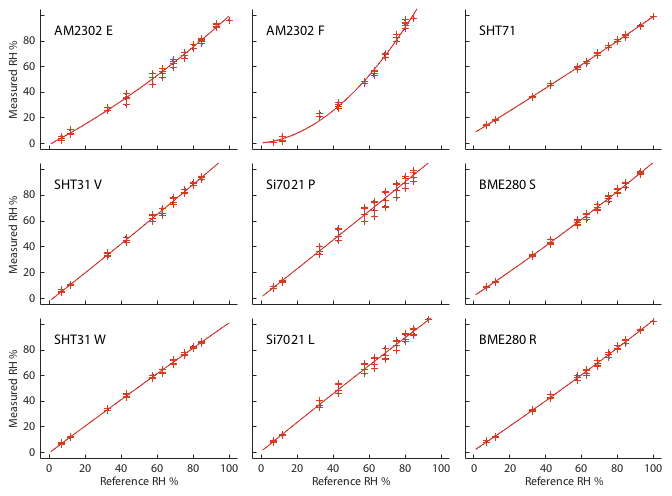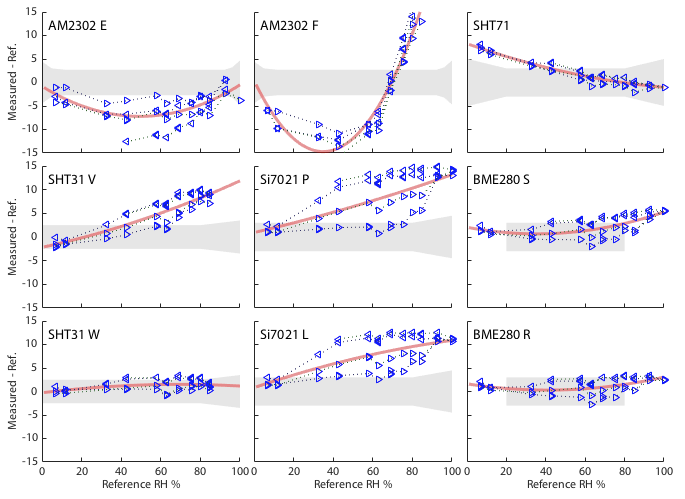Adding Sensirion SHT31 to the range of test hygrometers.
Page Contents
Introduction
This is an update and supplement to Wide range of Hygrometers: DHT22, AM2302, AM2320, AM2321, SHT71, HTU21D, Si7021, BME280. I will not repeat the detailed descriptions of the apparatus and methods that are given there and also in Test and Calibrate DHT22 Hygrometers.
I received some very friendly and helpful feedback from an engineer at Sensirion. We discussed two things; possible problems with sensor contamination which has been written up in 'Baking a possibly contaminated SHT71' and the availability of newer Sensirion devices such as the SHT31. He very kindly provided a couple of the SHT31 devices free of charge for me to include in my test sample. To be clear, at no point was there any suggestion of applying pressure to influence what I wrote. He simply seemed keen to help me get the best out of all these devices and understand how they worked, for which I am grateful.
This page therefore repeats the same experiment again, now expanding the sample of devices to include the Sensirion SHT31. The test method uses a variety of saturated aqueous solutions and the aparatus has all been previously described. One limitation here is that my aparatus relies on a heater for thermal regulation. That means I can only test at temperatures above ambient and I can only perform the previously reported bivariate analyses (0–100%RH, 5–35°C) in Winter. Without the ability to chill the test cell, the lower temperature limit is set by the ambient temperature in my garage. The results here are all at a fixed temperature of 25°C.
The devices included are a mixture of devices being re-tested and new ones:
- Aosong AM2302 (A.K.A. DHT22). These are the same two devices as have been in all previous test runs. They are two of the three remaining functioning devices from my original set of six. In terms of accuracy, they were by coincidence the best and the worst of the six.
- Sensirion SHT71. This is a new device, not the one that has appeared in all previous tests. I originally bought two SHT71 devices several years ago and have been using only the first until now. That device was used for the baking and reconditioning test. Here I removed the second device from its original packaging for the first time. Though in its original factory packaging, that was not a sealed airtight unit.
- Silicon Labs Si7021. Two are included, one each with and without the PTFE protective membrane. Both have appeared in previous tests such as 'Response speed of HTU21D and Si7021'.
- Bosch Sensortec BME280. Two brand new devices bought specifically for this test. These two sensors (identified as 'S' and 'R' in my logs) are also included in the test of BME280 absolute temperature accuracy.
- Two brand new Sensirion SHT31, very generously provided by Sensirion.
Looking back at previous tests, the devices that have been dropped and not incuded here are
- AM2320 and AM2321 which were all giving me frequent, intermittent errors and I have not yet bought any replacements to investigate further
- DHT11 which is not really a comparable sensor at all, being much cheaper and lower advertised specification
- HTU21D which was mainly omitted simply due to lack of space. I can only test up to nine simultaneously in my current setup. It has behaved consistently in all previous tests and those previous results should describe it adequately.
Results
To allow direct comparison, I present the results here in a similar format to all the previous write-ups. The one slight change is that in Figure 2 I have integrated the hysteresis information and calibration fits into a single figure. Figure 1 shows the direct comparison of raw sensor reading to the reference data whereas Figure 2 shows the inferred measurement error for each sensor as a function of humidity. All data were obtained at a regulated, constant 25°C. The red curve is a quadratic fit to those data. The black dotted line (Figure 2 only) joins the data points in the sequence in which they were obtained and thus circumscribes the hysteresis envelope that shows how the device's output is biased by its recent history.


SHT31
Two devices were tested and I was a little surprised to get very different results. One (W) is absolutely excellent and as good as any device I have tested so far. The second (V) was about average and similar to devices from a variety of manufacturers. Overall that is obviously a win; one device is as good as the rest and one is much better then most. Still, it is a shame that they did not both come out so well. Hysteresis is a little better than average but not as good as the SHT71. As stated in the introduction, I have been unable to do a full temeperature calibration this time so only have results at 25°C. I have no test of reliabilty or longevity, but on the basis of how durable the Sensirion SHT71 has been on very long time scales I am hopeful it will last well.
One negative point for the SHT31 is you will note there are no data plotted for the two highest humidity points, potassium chloride and potassium nitrate. The output values from the SHT31 are capped at 100% (see datasheet, section 4.13). For normal day-to-day use there is a lot of sense to this. In typical usage outputting values of humidity >100% is nonsensical and potentially confusing. For this experiment though when I am trying to derive a recalibration curve it is useful to allow values >100% or <0%. See for example the Si7021 devices. For potassium nitrate they were outputting values around 110% but I am able to plot those values and derive a correction curve. Since the SHT31 is capped at 100% any value above that is no use and cannot be plotted. The same issue is even worse for AM2302 F on which the top three reference solutions are not plotted.
SHT71
The sensor was accidentally dropped into the saturated NaBr solution half way through the experiment and sat immersed in the solution for several hours before being rescued. I soaked it in distilled water for a day, rinsed a couple of times in fresh distilled water and let it dry at room temperature. Half the data in this plot are before the dunking and half afterwards. I see no difference at all. The device perfectly survived being immersed in saturated NaBr with no ill effects. This is the only one of my sensors to have suffered this test but it is nonetheless impressive. Despite previous comments on the risk of sensor element contamination they are clearly not that delicate. The Sensirion engineer I spoke to (and the data sheet) suggested that problems are normally caused by volatile organic compounds (VOC, e.g., hydrocarbon fuels, oil paint thinners, nail varnish remover, outgassing polythene etc) rather than acqueous solutions.
This is the second of my two SHT71 and it shows exactly the same linear calibration error as my first one did. It seems possible that both these devices were contaminated by some unknown VOC in the supply chain before I got them, but I have no way to prove that either way. See 'Baking an SHT71' for more discussion.
BME280
These are two new devices being tested for the first time. The calibration is within specification over almost the entire range for both devices. Only device S slips very slightly out of range at high humidity. All previous BME280s tested have performed equally well. There is some evidence that they may degrade over timescales of about a year to the point where they perform comparably to most of the others. With such small samples of sensors being tested though it is impossible to say anything definitive on that. It is also likely highly dependent on the environment in which they are operated.
AM2302 / DHT22
Results remain consistent with all previous test runs. These two devices are just as good and bad as they have previously been. Sensor E remains very good. At 25°C it is within specification and shows virtually no hysteresis. Though not investigated further, sensor E appears to be starting to diverge wildly off its previous performance at the very end of the test with the last three readings being −12% off the reference. Has this device finally now failed? I do not know.
Si7021
These data look exactly like previous tests. They seem to have been nicely stable over time. This is the first time I have tested two Si7021 together in the same cell and they are very similar to each other. Both show a similar calibration deviation and both exhibit the same large hysteresis. I remind you that these are one each, with and without the PTFE membrane installed.
If you have comments or suggestions feel free to contact me:
References: See here.
Acknowledgements:
- Many thanks to gentleman from Sensirion who took the time and effort to contact me about the problems I was having with my SHT71 and generously donated the SHT31 for me to test here. This probably does not need saying, but I should make it clear that Sensirion has never tried in any way to coerce me to write this update or change anything that I had previously written.
- Descriptions of software libraries used may be found here.
2018-02-26 8:44 PM